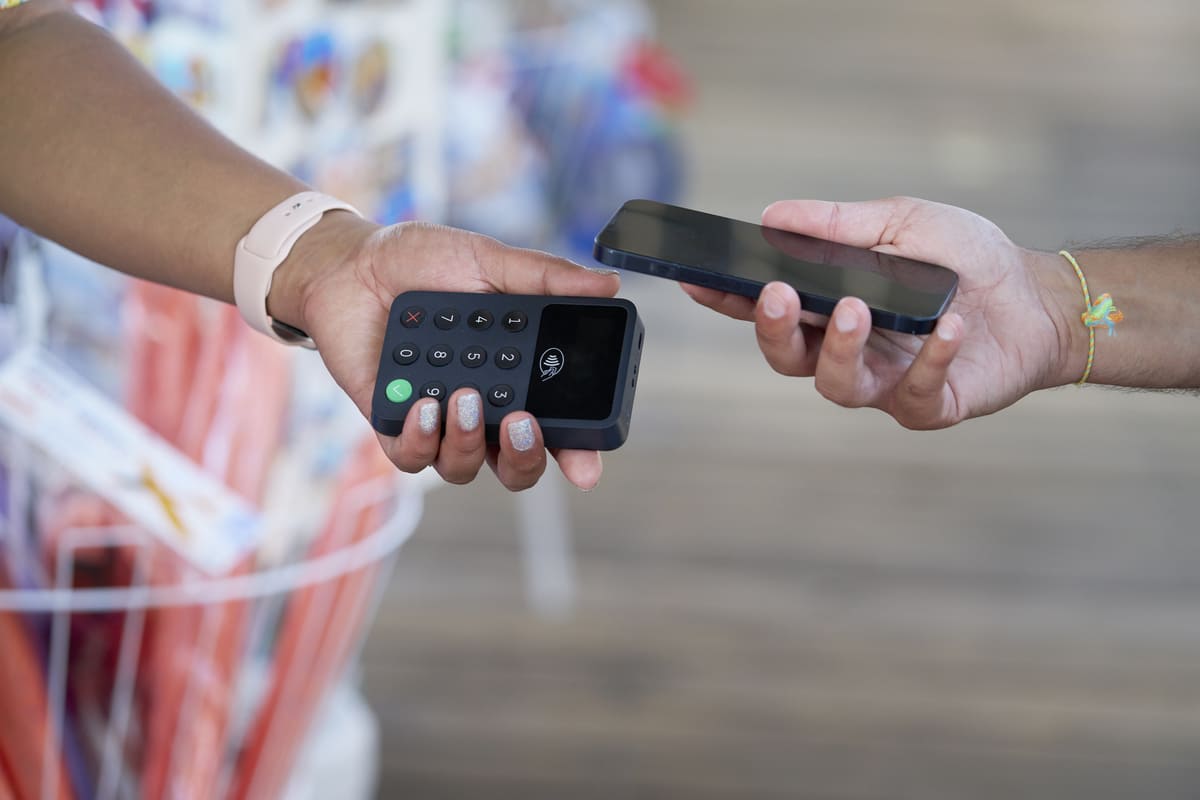As technological advances reshape many facets of our world, from AI to digital marketing, the way we pay for things has changed too. One of the important evolutions is contactless payments, a term you’ve likely come across but might not fully understand. If you’ve ever asked what are contactless payments or puzzled over symbols on your credit card or at your local store checkout, read on to find out more.
What is contactless payment?
Contactless payment is a secure method for consumers to buy products or services using a debit, credit or smartcard – also known as a chip card – or smartphone by using RFID (radio frequency identification) or near-field communication (NFC) technology. To pay for something with a contactless card, you simply hold the card near an NFC-enabled device, such as a payment terminal.
This kind of transaction requires no physical contact between the consumer’s smartphone or credit card and the POS (point of sale) system. In simple terms, it’s a touch-and-go system. You may have come across other expressions such as ‘credit card wifi symbol’, ‘contactless msd’, ‘tap payment ‘ and ‘payWave ‘. These are all different ways people refer to what essentially amounts to the same concept: contactless payments.
The primary appeal lies in rapid customer services and convenience. Transactions are faster because there’s no need for PIN input or a signature for most purchases. Grasping how these technologies work starts by understanding their conception, which takes us back to the brief history of contactless payment technology. So when did contactless payment become available?
Learn from the best in the business with insights into cutting-edge techniques shaping the future of hospitality with our advanced courses

A brief history of contactless payment technology
Contactless payments have come a long way from their origins in the late 1990s. Starting with RFID for inventory tracking, they evolved into today’s popular technology. Here’s an overview of its development:
- 1997: ExxonMobil introduced Speedpass, bringing the earliest version of the RFID payments system into view. It was an electronic toll collection system designed to simplify fuel payments
- Early 2000s: building upon ExxonMobil’s idea, major credit card companies such as Mastercard ventured into the realm of wireless payments, marking the onset of players experimenting with contactless paying at points-of-sale
- Mid-2000s: credit card companies started equipping cards with built-in NFC technology (near-field communication chips) heralding the birth of tap-to-pay, a term now seen everywhere with contactless payment systems
- 2011 and beyond: with Google Wallet paving the way for phone-based digital wallet payments in the US, smartphones became tools that could act like banking cards, marking the beginning of mobile tap and payWave
- Recent years: credit cards use NFC chips, along with numerous other devices such as smartwatches or wearable technology, which can be used for monetary transactions conducted in-store or online through e-wallet or banking apps
Combining insights from leading professionals and opportunities for real world experience, our course provides a platform for mastering the ways digital innovation is shaping hospitality.

How does contactless payment work?

To initiate a contactless transaction, you first need an active device, often your card or smartphone, featuring an embedded chip and radio frequency antenna. These components are responsible for transmitting your payment data wirelessly once activated.
Here’s how it works:
- The merchant will key in the transaction details into their point-of-sale terminal
- You then tap your contactless-enabled card, phone, or wearable near the indicated area of the terminal
- A process known as card emulation occurs where your device’s NFC chip essentially becomes your credit or debit card
- Your account information is encrypted and sent through radio waves to complete the transaction quickly and securely
It’s worth noting contactless credit cards and mobile wallet payments such as Apple Pay or Google Wallet follow the same principle – tap to pay at stores accepting these platforms as a form of payment.
Types of contactless payments
There are three primary types of contactless payments: contactless payment cards, mobile wallet payments, and wearables. Below, we look more closely at each of them.
Contactless payment cards
These cards allow transactions via a simple tap on the terminal reader. They have an embedded chip and antenna that use radio frequency identification (RFID) or NFC technology. The presence of a wireless symbol, often known as the credit card wifi symbol, indicates the capability for contactless transactions. Cards such as Visa payWave offer convenient, PIN-free transactions within specified limits.
Mobile wallet payments
Mobile wallets such as Google Pay and Apple Pay store digital versions of payment cards securely within smartphone apps. After setup, payments are made by holding the phone near a compatible terminal – no card swiping or signing is required.
Wearables
Wearable devices such as smartwatches and jewelry with NFC chips allow contactless payments. They use NFC technology, enabling users to make payments by tapping their wrists on compatible devices. While not yet widely adopted, wearables hint at the potential future growth of even more versatile touch payment options.
Advantages and disadvantages of contactless payment
It’s important to know the pros and cons of using contactless payments. Let’s look at some of the ways it can help a business and some of the problems it can cause.
Advantages
- Convenience: contactless payments provide unparalleled convenience. With just a tap of your card or device, transactions are completed swiftly, reducing waiting times and introducing an efficient ‘pay and go’ system
- Compatibility: contactless payments are easily accessible, as they can be made using different devices, such as NFC-enabled credit cards or smartphones with apps such as Google Pay, ensuring flexibility for users
Disadvantages
- Security concerns: although contactless payments offer convenience, there are inherent security risks. One of the primary concerns is unauthorized transactions resulting from lost cards or phones. Despite efforts to mitigate these risks by implementing payment limits, the potential for misuse still remains
- Choice overload: with the wide range of payment options available today, some users may find this overwhelming if they are used to more traditional methods
How secure is contactless payment?
Concerned about the security of contactless payments? Let’s look at some of the issues.
- Encryption: contactless payments use encrypted data for each transaction, making it highly secure. Unique encryption codes prevent the replication of transactions
- Transaction limits: many countries set transaction limits. In the UK and Canada, you’re prompted for a PIN or signature above certain amounts
- Stolen card: if your card is stolen, thieves can only use it within the transaction limit. Your liability depends on quick reporting and issuer policies
- Additional protection: financial institutions offer safety features such as Zero Liability Protection against unauthorized transactions, account monitoring alerts for irregular activities and secure remote commerce systems for online shopping.
While no system eliminates fraud completely, protective measures significantly reduce risks in contactless payments. Use this information to confidently tap away next time you make a transaction.
Description – Discover how to strategize and fully capitalize on technological innovation with our tailor-made courses.

How many contactless payments can I make in a day?
The number of contactless payments a person can make in a day varies depending on factors such as the policies set by the bank, regulations in the country and the chosen payment method.
Banks initially introduced transaction restrictions as a security measure to protect their clients. However, with advances in technology, many institutions have adjusted or removed these limitations. Some banks still enforce a maximum number of daily transactions, while others focus on setting a total daily spending limit. It’s worth noting different countries may have different regulations in place, such as setting a maximum amount per individual transaction.
What happens if the terminal Is not contactless-enabled?
As contactless payments become more popular, it’s important to explore the challenges that arise when terminals don’t offer the option to simply tap and pay. If terminals do not have NFC support, you will not be able to use devices such as mobile phones or contactless cards. However, traditional methods are still available for payment such as:
- Swiping: slide your card through the magnetic stripe reader
- Inserting: dip your chip-enabled card into the designated slot
- Manual entry: input card details if needed.
Most cards are designed with versatility in mind, featuring a magnetic swipe as well as a contactless payment chip. Before making any transaction, verifying the available payment methods to avoid delays or confusion can be a good idea.
FAQs on contactless payments
Some of the more frequent user inquiries around contactless payment methods include the following:
Which stores accept contactless payment?
Businesses worldwide are rapidly adopting this payment method because of its many benefits, including fast transaction times and robust security features. Whether it’s small local shops or large multinational chains, establishments that display the contactless symbol generally provide this convenient checkout option.
How can I pay contactless with my phone?
To ensure a smooth payment process, be sure to save your credit card information in your preferred digital wallet app ahead of time. When you’re ready to pay, simply unlock your device and hold it near a compatible reader at the checkout counter.
Is there a limit on contactless payments?
Many banks have introduced daily spending limits for transactions made using touch-payment devices. These limits can vary depending on the type of account and the location.
What does payWave mean?
Visa has created a convenient contactless payment solution called payWave that uses NFC technology. This enables seamless and hassle-free transactions at retail locations by simply tapping compatible devices on functioning readers.
Conclusion
As technology becomes a bigger part of daily lives, contactless payments have emerged as a convenient and efficient way to conduct transactions. Whether using cards, mobile wallets, or wearables, the convenience offered is matched by a strong focus on security. By embracing the advantages while acknowledging any limitations, you will be equipped to harness the best features of contactless payments and the benefits they offer.
Photo Credit
Main Image: We Are/DigitalVision via Getty Images




